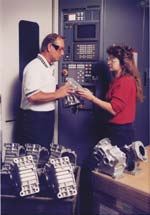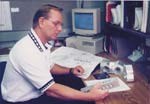Easier, Flexible Estimating Helps Contract Manufacturer
This company used to calculate estimates for parts with a large, internally developed Excel macro, according to their systems administrator. But about 2 years ago, the company went looking for a computer-aided estimating system. Here's what they found.
With 700 employees and 10 facilities, Citation Custom Products (CCP) produces a total of $115 to $120 million in sales annually. The company's Menomonee Falls, and Oconomowoc, Wisconsin, locations combined have approximately 600 employees and 300 machine tools, including a variety of horizontal and vertical machining centers for both low and high speed machining processes.
The majority of CCP's work, approximately 60 percent, comes from the automotive industry, says senior project manager Art King. CCP supplies first through third tier automotive companies with parts for brake, fuel and steering systems, as well as engine parts.
The company used to calculate estimates for parts with a large, internally developed Excel macro, according to Greg Smith, systems administrator. But about 2 years ago, the company went looking for a computer-aided estimating system.
Ease of use for the entire company was the main reason behind the decision to purchase a dedicated estimating program, according to Mr. King. He said other considerations involved in the decision were the desire for an integrated material library and the ability to work with versatile equipment utilization parameters.
To find a program that offered these features, Mr. King researched products at trade shows and visited other manufacturing facilities to see their estimating systems in action.
In the end, CCP decided to purchase Machine Shop Estimating from Micro Estimating Systems (New Berlin, Wisconsin) because of the system's ability to adapt to different situations that could arise on the shop floor, as well as its ability to calculate estimates using different equipment and types of materials. To make the software even more flexible, Mr. King worked with CCP's machine operators to customize the system's standard speeds and feeds database with machine-specific CCP data.
"I worked with our machine tool people to get the equipment data and parameters to build our own database and to make it a little easier to use various equipment. We did comparisons of jobs on the floor with given rates. I wouldn't say we're 100 percent refined on our numbers, but we have done some studies to try to make it as realistic as possible compared to what's happening on the floor," he says. In addition to the time comparisons, Mr. King also added historical data from the shop floor to the speeds and feeds library. "Because of that information, our speeds and feeds library is almost like a historical document that is continuously updated, depending on the opportunities we have to work with each piece of equipment, and the data that have been collected at that time."
Some of the processes covered in the customized database include new machine tools with higher spindle rpm for high speed machining, using high pressure coolants.
Mr. King created high speed and low speed scenarios in the speeds and feeds library with a directory for each machining style.
"The process was very similar to that of adding historical data," he explains. "Obviously, it's very important to be as accurate as we can. That's why we created the files we have using historical data."
Because of the historical data the shop had available, Mr. King says the amount of time dedicated to the initial customization was not as great as could be expected. That data was combined with information on materials from the program library. Mr. King said he initially used about one-third of the more than 1,100 materials available, and he has gone back to the library for others as they have been needed since.
The company's emphasis on historical data extends to its treatment of the estimates themselves. When orders come in for repeat jobs, having old estimates as historical documents allows CCP to update each bid quickly and easily.
However, due to the design cycles involved with some products, in many cases whatever you're quoting may not become reality for 6 months, or sometimes maybe a year, Mr. King says. "We work with customers on new project design all the way up to current production products. If there is a very similar part, or a repeat, we have the ability to pull up the old information at a later date. We've got easier access to more information than we had before. MSE allows us to maintain historical data, and the quote itself is historical data to us."
With between 15 and 20 seats of MSE on its network, split between project management and manufacturing engineering, CCP developed more than 600 estimates in its first full year using the software. Mr. King credits MSE, and the information stored in its databases, with providing more detailed information for the company's estimating process, including itemized breakdowns of speeds and feeds in comparison to utilization. He says that information makes the firm's estimates more accurate.
"It gives us a little more detail and lets us store, or retain, more data than we used to be able to," he explains.
Related Content
Finally, A Comprehensive Software Solution Designed for Small Job Shops
Zel X from Siemens is an integrated software application that consolidates collaboration, design, manufacturing, and operations into a comprehensive, easy-to-use solution. From RFQ to delivery, it’s a more efficient way to handle quotes, manage jobs, make parts, and collaborate with teams of all sizes.
Read MoreShop Quotes Smarter, Works Harder with Machine Monitoring
Temco first installed MT-LINKi to optimize quoting. Now, the software helps the shop optimize its machines — and machine purchases.
Read MoreHow this Job Shop Grew Capacity Without Expanding Footprint
This shop relies on digital solutions to grow their manufacturing business. With this approach, W.A. Pfeiffer has achieved seamless end-to-end connectivity, shorter lead times and increased throughput.
Read MoreShop Moves to Aerospace Machining With Help From ERP
Coastal Machine is an oil and gas shop that pivoted to aerospace manufacturing with the help of an ERP system that made the certification process simple.
Read MoreRead Next
The Cut Scene: The Finer Details of Large-Format Machining
Small details and features can have an outsized impact on large parts, such as Barbco’s collapsible utility drill head.
Read More3 Mistakes That Cause CNC Programs to Fail
Despite enhancements to manufacturing technology, there are still issues today that can cause programs to fail. These failures can cause lost time, scrapped parts, damaged machines and even injured operators.
Read More









.png;maxWidth=300;quality=90)


.png;maxWidth=300;quality=90)














